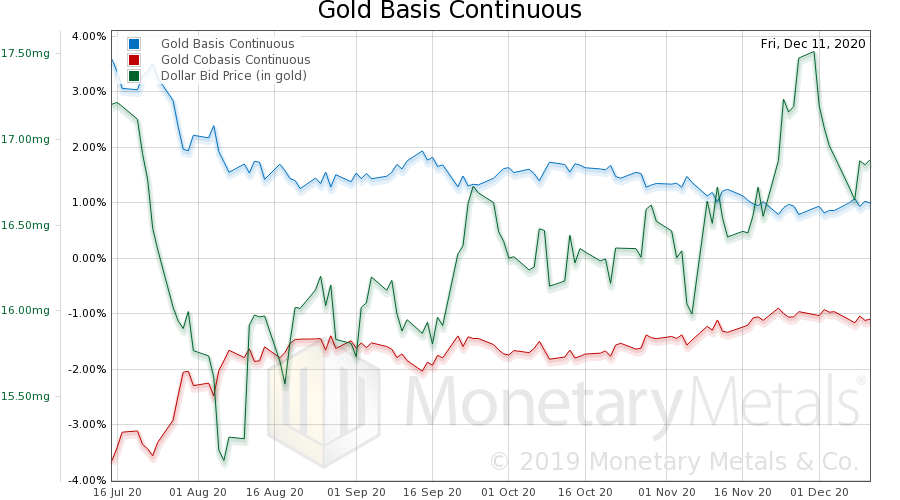We have written much on the topic of economic measurement. Does the dollar measure gold, is it appropriate to say that “gold went up”? Or does gold measure the dollar?
Does a line of gummy bears laid out on the kitchen table measure the ruler? Does one stretch some rubber bands one day, and say that “the steel meter stick is 6.8 rubber bands long”, but the next day observe that it has gotten longer and is now 7.1 rubber bands long? Does the sinking ship in the stormy seas say that the lighthouse is going down and up, but mostly up?
Consumer Prices & Wages
If you drop both a brick and a board over the edge of a cliff, they both fall. But the brick falls a bit faster, thanks to its higher mass to surface area ratio. Now, picture a camera mounted on the brick. It would see the board going up. This is an excellent analogy for consumer prices and wages respectively. Both have been falling for decades, with consumer prices falling a bit faster than wages.
As an aside, the conventional measure of inflation blinds one to this phenomenon. That’s because it treats the hypothetical real consumer prices as a constant, and attempts to measure the money and everything else based on it. In reality, consumer prices are anything but constant. And therefore, any methodology that assumes they are is fundamentally flawed.
Mainstream Prevailing “Wisdom”
To be admitted inside the mainstream Overton Window, it is practically a requirement that one must categorically refuse to measure the dollar in gold. One must talk of gold going up and down, as if it were a volatile commodity like oil or cocoa.
However, it’s perfectly acceptable to measure the dollar in terms of paper currencies which derive from the dollar. Even though these currencies have a fraction of the dollar’s stocks, a fraction of its flows, and a fraction of its stocks-to-flows ratio. In other words, the dollar may not be measured in gold but it may be measured in pounds and yuan. Or a basket of such currencies.
The truth is that the dollar may not be fit for measuring gold. But it’s an adequate measure for the euro and yen.
The difference between the measurement paradigm that we propose, and the mainstream, is not merely ideological, pedagogical, tendentious, or pedantic. It is that they lead to opposite conclusions.
Imagine believing that your steel meter stick has grown in length. Or the disaster that would befall if one thought that an object falling off a cliff were actually rising. Imagine the macro view that would come out of thinking that the dollar is falling based on watching the rise of the euro and the Brazilian real.
Disseminating Doubt & Confusion
So let’s look at an article that we came across this week. The headline blares, “U.S. dollar hovers around two-and-a-half year low; Analysts see further weakness in 2021”. And the article contains the usual bumper-sticker analysis of inflation, which readers are supposed to think will be confined only to the dollar and hence help bolster the idea of the dollar going down.
However, if you look past the headline, the article paints a picture that is bright, not dark. Based on a Covid vaccine, a Biden victory, more stimulus spending, loose policy at the Fed, and everything else that the writer thinks should be good for the economy, the article makes the case for another big risk-on trade.
Stocks, real estate, emerging market currencies, and even high-beta developed market currencies like the Norwegian Krone and Kiwi dollar are all rising.
In other words, the article is admitting that other currencies are going up, along with everything else. The funny thing about articles that obscure how things really are—reality usually seeps through anyway.
The Real Question
This article should not be taken to be about the falling dollar. It is really about the latest boom, juiced up by the usual means: more welfare spending and more credit expansion at lower interest rates. Plus Biden getting elected. Things that many people want to be good, but which aren’t.
Now let us answer the question, as we are almost uniquely qualified to do. Is the dollar falling?
Over the last week, the dollar went from 16.72mg gold to 16.88mg, a gain of just about 1%. Gold is money. It’s what you hold, when you don’t trust investments. The alternative is to buy investments. Which people might do if there’s a vaccine, and the Treasury is almost certainly to dole out another multitrillion dollar stimulus and bailout.
What would you rather have? A gold bar, gathering dust in a vault, or stock in a company that’s about to get their fair share of these trillions, plus borrow even more at even dirtier-cheaper rates so it can buy your shares back at a big gain?
Reserve Your Chair
Everyone knows the music will stop playing at some point, and only those who have a chair will be safe. Chuck Prince, CEO of Citigroup back in 2007, said:
“When the music stops, in terms of liquidity, things will be complicated. But as long as the music is playing, you’ve got to get up and dance. We’re still dancing,” he said.”
That is how we see the boom today. The Monetary Metals office is in a space run by a competitor to WeWork. Before Covid, the individual offices were over 90% rented. Today, about two thirds are empty and many of the ones that still have stuff in them are dark five days a week. We wonder how many will be emptied when their leases run out. We wonder if it will default on the loan which financed the buildout of this space.
This coworking space is located in a mall. And now, the mall is a ghost town. On weekdays—this is just before Christmas!—it feels as busy as it was in the middle of July in 2009.
GDP & Jobs Are…Growing?
They say that GDP is growing. Perhaps our central planners have fully substituted for the lack of production—and hence income—with borrowed cash doled out in lieu of revenues and wages. They say that jobs are growing. This, despite nearly a million new unemployment claims per week. Maybe.
Is this the time to dump all your gold, to buy investments whose returns depend on the real economy? We doubt anyone is doing that. Is this the time to dump gold, to buy investments whose returns depend on Fed and Treasury largesse? Clearly some people have. They have bought the dollar up from its all-time low of 15.13mg in early August to its present 16.88mg.
Or perhaps they have sold gold under duress, due to business failure and lack of income to pay for groceries. There could be more of that coming, assuming that the government allows banks to foreclose on defaulted mortgages and landlords to evict nonpaying squatters. Or perhaps they will stimulate us so bigly that it lasts the whole calendar year 2021.
Gold Fundamentals
Here is an update on the gold basis.

We see a general correlation between rising dollar price (i.e. falling gold price, when measured in gummy-bear rubber-band dollars). This is rising scarcity of gold as the dollar rises, which means the price action is driven predominantly in the futures market.
Those who wish to speculate for big price gains see little reason to be in the gold market, right now. Why should they, when bitcoin has a shinier story and hotter price action at the moment?
Gold Is….Corruptible?
That reminds us. Someone sent us a link to a video in which Michael Saylor said gold is corruptible because it’s an open system. He means that miners can produce more gold. To paraphrase Inigo Montoya, he uses that word corrupt, but we do not think that that word means what he thinks that it means.
People eat this stuff up because it helps them confirm their bias. Bitcoin to $200,000! And you can hold it for 100 years, that’s the ticket. And gold is corrupt!
Speaking of corrupt, what will happen when those who run the computers that maintain the bitcoin blockchain encounter billions of incentives to increase the quantity from 21 million to just a few more? Will they be like Denethor with the One Ring, putting this capability deep in the vaults, only to be used in the utmost end of need? Or more like Boromir, who would have killed Frodo to take it?
In the video, Saylor, an engineer, says that it’s better to have an engineer than a politician run the monetary system. We agree with him that it would be terrible to have a politician run the system. The one thing worse than having an irredeemable currency borrowed into existence by a central bank, is a totally unbacked currency printed into existence by a legislature.
But he suffers from what Hayek called the “fatal conceit”. We need a free market to govern such things as quantity of money. Not an expert central planner, not even an expert engineer. By the way, Keith was trained in computer science, and was a software engineer and architect for over 20 years.
It just does not do, to dictate a magic number like 21,000,000. There is no right quantity, which is changing in real time. And even if there were, no central planner would be able to know it. Not even an engineer.
And this leads us to an important point relevant to anyone who participates in the monetary conversation. Do not confuse “it’s going up” with monetary policy. The former is about making more dollars on your speculation. If you see an opportunity to do so, then by all means go for it. We never blame the speculators; we blame the Fed for forcing people to be speculators.
The latter is about the stability of the monetary unit. This is necessary for borrowers to incur long-term liabilities without fear they will go up 1,000,000 times, and for savers to keep their life savings without fear they will go down by 99%.
The Gold Exchange Podcast
After repeatedly being asked to start a podcast, we’ve finally launched one. We’ll dive into economics, monetary policy, investing, and precious metals. The first few episodes are now available. To subscribe, visit The Gold Exchange Podcast.

